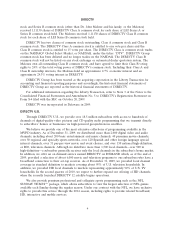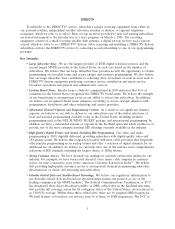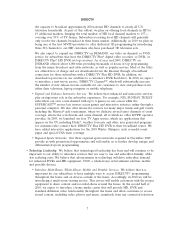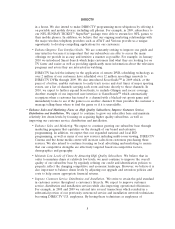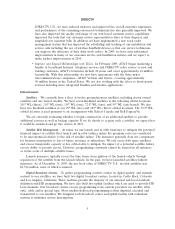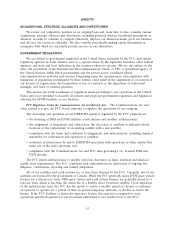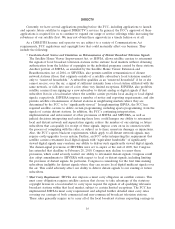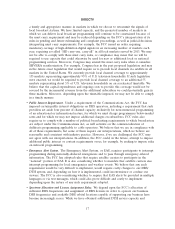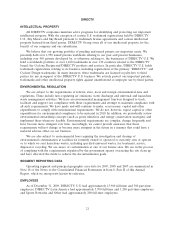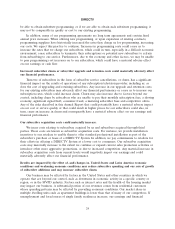DIRECTV 2009 Annual Report Download - page 26
Download and view the complete annual report
Please find page 26 of the 2009 DIRECTV annual report below. You can navigate through the pages in the report by either clicking on the pages listed below, or by using the keyword search tool below to find specific information within the annual report.DIRECTV
do not have a backup, however we have arranged to lease a backup satellite which was successfully
launched in February 2010 that will serve Sky Brazil and Sky Mexico. We anticipate that this satellite
will be available for operations in the second quarter of 2010.
See Item 1A. ‘‘Risk Factors’’ below for additional information regarding satellite launch and
operational risks.
Our principal digital broadcast centers are located in the United States and Brazil. We also have
several smaller satellite uplink facilities in the region.
Competition
The pay television and other emerging broadband video and data markets in Latin America are
highly competitive. In each of our markets, we compete primarily with other providers of pay television,
who distribute their programming by satellite, cable, terrestrial microwave systems, traditional
over-the-air broadcasting or the Internet. In addition, in certain markets we face significant competition
from illegal and informal sector pay television operations. We compete primarily on the basis of
programming selection, price, technology and quality.
In most of the markets in which we operate, cable television is our principal competition. Cable
services have been in commercial operation longer than other pay television platforms, and have
established large subscriber bases and widespread brand recognition. They have typically offered analog
services for lower monthly fees and with lower upfront installation and connection fees than we do. In
addition, the cable operators with which we compete are in various stages of upgrading their networks
to provide broadband and telephony services, and in some markets the major cable operators are
competing with us based principally on their offer of a ‘‘triple play’’ bundle of video, broadband and
telephony services. In most cases, they discount the value of their programming services in order to sell
broadband and telephony services, which can adversely affect the attractiveness of our offers to
subscribers.
In addition to competition from cable services, we face increasing competition from other
providers of DTH services. Telefonica, the Spanish telephone company, launched DTH services in Peru,
Chile and Brazil in 2006, Colombia in 2007 and Venezuela in 2008. Telmex provides DTH service in
Chile and Peru, and in 2009 it launched services in Brazil through its affiliate, Embratel. Oi, the second
fixed line incumbent in Brazil (in addition to Telefonica), launched a DTH service in 2009. Also, in
Mexico a joint venture of EchoStar Corp. and MVS Comunicaciones launched a new DTH service,
with substantial commercial support and cooperation from Telmex, which due to regulatory restrictions
is not currently permitted to provide its own video services in Mexico. These competitors have
significant resources and have proven their ability to grow their businesses rapidly. They typically seek
to focus on offering lower-cost, limited services packages in support of their telephony and broadband
offerings, which can increase our churn and put pressure on our margins. Also, the existence of
multiple DTH operators in a single market dilutes our ability to market our DTH service as an
alternative to cable, traditionally our principal competition.
In a number of markets, existing wireline telephony operators have announced their intention to
upgrade their infrastructure in order to provide new and enhanced services, including video
programming. These and other companies have announced plans to build wireless broadband networks
that will also be capable of delivering broadband, telephony and video services. However, to date only a
very small number of such upgrades and build outs have been actively pursued on other than a test
basis.
14


